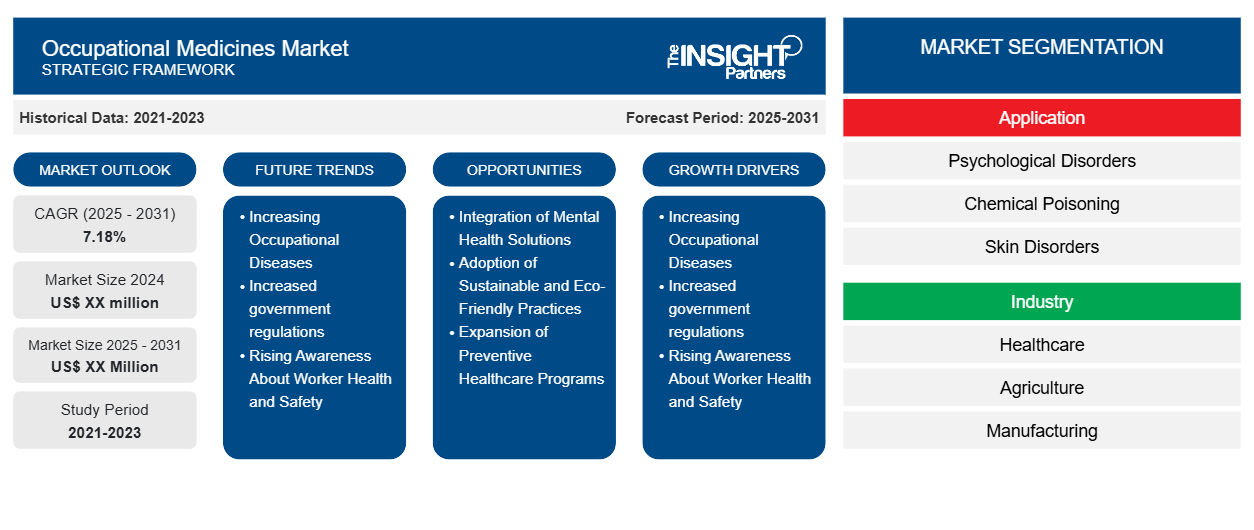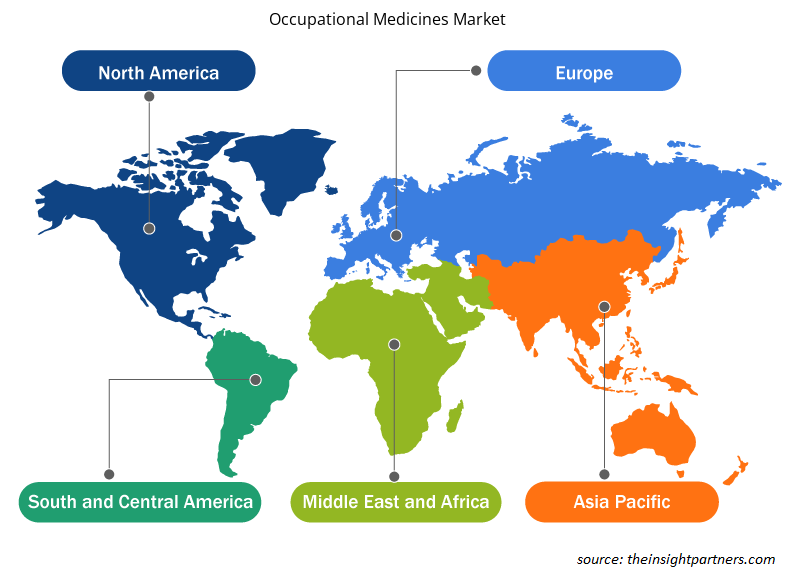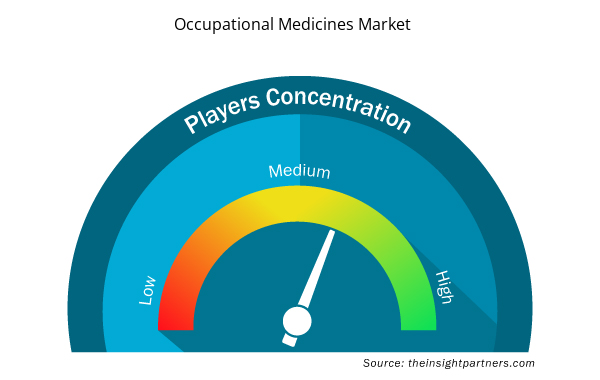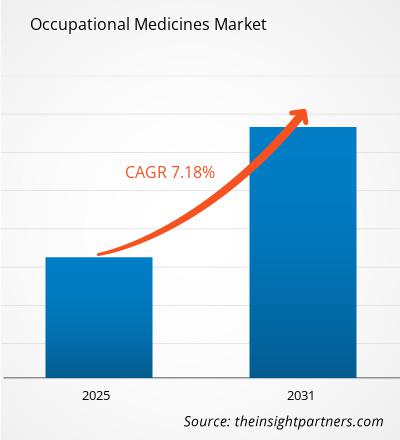The Occupational Medicines Market is expected to register a CAGR of 7.18% from 2025 to 2031, with a market size expanding from US$ XX million in 2024 to US$ XX Million by 2031.
The report is segmented by Application (Psychological Disorders, Chemical Poisoning, Skin Disorders, Chronic Respiratory Diseases, Musculoskeletal Disorders, Others); Industry (Healthcare, Agriculture, Manufacturing, Construction, Petroleum and Mining, Others); and Distribution Channel (Hospital Pharmacies, Retail Pharmacies, On-line Pharmacies). The global analysis is broken down at the regional level and for major countries. The market evaluation is presented in US$ for the above segmental analysis.
Purpose of the Report
The report Occupational Medicines Market by The Insight Partners aims to describe the present landscape and future growth, top driving factors, challenges, and opportunities. This will provide insights to various business stakeholders, such as:
- Technology Providers/Manufacturers: To understand the evolving market dynamics and know the potential growth opportunities, enabling them to make informed strategic decisions.
- Investors: To conduct a comprehensive trend analysis regarding the market growth rate, market financial projections, and opportunities that exist across the value chain.
- Regulatory bodies: To regulate policies and police activities in the market with the aim of minimizing abuse, preserving investor trust and confidence, and upholding the integrity and stability of the market.
Occupational Medicines Market Segmentation
Application
- Psychological Disorders
- Chemical Poisoning
- Skin Disorders
- Chronic Respiratory Diseases
- Musculoskeletal Disorders
Industry
- Healthcare
- Agriculture
- Manufacturing
- Construction
- Petroleum and Mining
Distribution Channel
- Hospital Pharmacies
- Retail Pharmacies
- On-line Pharmacies
Customize This Report To Suit Your Requirement
You will get customization on any report - free of charge - including parts of this report, or country-level analysis, Excel Data pack, as well as avail great offers and discounts for start-ups & universities
Occupational Medicines Market: Strategic Insights

- Get Top Key Market Trends of this report.This FREE sample will include data analysis, ranging from market trends to estimates and forecasts.
Occupational Medicines Market Growth Drivers
- Increasing Occupational Diseases: The rising prevalence of occupational diseases are major growth factor in the Occupational medicine market. As the world continues to industrialize and urbanize, more people are subjected to toxic chemicals and hazards at work that make them susceptible to occupational diseases including respiratory disease, musculoskeletal injury, occupational cancers and skin diseases. The risk of such conditions increases in workers in construction, mining, manufacturing, and medical facilities who have worked for a long time around toxic asbestos, chemicals and fumes. Thus the demand for niche medicines and treatments to combat and even prevent them has grown. In addition, government policies and workplace safety laws have become increasingly concerned with employee health and safety, making employers adopt onsite healthcare. This increasing occupational health need is driving the Occupational Medicines market in such a way that pharmaceutical firms are being able to research and provide customized interventions for occupational health disorders. Growing knowledge of the value of worker safety is also encouraging the implementation of workplace health programs, which inevitably leads to an increase in the use of medication to prevent or treat occupational diseases.
- Increased government regulations: Increased government regulations and workplace safety compliance are further driving the Occupational Medicines market. Various national and international bodies such as the World Health Organization (WHO) and the Occupational Safety and Health Administration (OSHA) are setting standards for work injuries and illnesses. These policies require health insurance coverage, vaccination programs, and routine medical examinations for workers, especially in hazardous occupations. The governments also invest in occupational health surveillance to monitor the spread of diseases and injuries across industries. While the standards are increasing in safety, employers are more engaged in getting workers access to the correct medications and preventive health care. And workers’ compensation schemes are encouraging occupational medicines to treat chronic diseases resulting from workplace injury. These regulations are increasingly being enforced and the industry is calling for preventive care, vaccines and treatments, especially for respiratory disease, musculoskeletal disease and work-related mental health problems. Hence government policies are driving the growth of the Occupational Medicines market and also opening great opportunities for pharmaceutical companies to offer niche products and services.
- Rising Awareness About Worker Health and Safety: Increasing focus on employee health and safety is driving the Occupational Medicines market. Workplace injury and chronic disease are becoming increasingly serious issues for companies and industries that care about the health and well-being of workers. Increasing focus on mental health at work, the Occupational medicine market is registering growth in medications to combat stress, anxiety, and depression among employees. We also have ergonomic products, vaccines, and drugs for repetitive strain injuries. Employers are also putting money into employee wellness, a program designed to create healthier workplaces, which may consist of routine screenings, fitness training, and nutrition education. With such programs becoming more commonplace, the need for medications to cure and prevent occupational ailments increases further. As the emphasis shifts towards health-promoting and preventive medicine, the Occupational medicine market is growing to suit the employer as well as the employee for improved health and increased productivity in the workplace.
Occupational Medicines Market Future Trends
- Increasing Occupational Diseases: The rising prevalence of occupational diseases are major growth factor in the Occupational medicine market. As the world continues to industrialize and urbanize, more people are subjected to toxic chemicals and hazards at work that make them susceptible to occupational diseases including respiratory disease, musculoskeletal injury, occupational cancers, and skin diseases. The risk of such conditions increases in workers in construction, mining, manufacturing, and medical facilities who have worked for a long time around toxic asbestos, chemicals,s and fumes. Thus the demand for niche medicines and treatments to combat and even prevent them has grown. In addition, government policies and workplace safety laws have become increasingly concerned with employee health and safety, making employers adopt onsite healthcare. This increasing occupational health need is driving the Occupational Medicines market in such a way that pharmaceutical firms are being able to research and provide customized interventions for occupational health disorders. Growing knowledge of the value of worker safety is also encouraging the implementation of workplace health programs, which inevitably leads to an increase in the use of medication to prevent or treat occupational diseases.
- Increased government regulations: Increased government regulations and workplace safety compliance are further driving the Occupational Medicines market. Various national and international bodies such as the World Health Organization (WHO) and the Occupational Safety and Health Administration (OSHA) are setting standards for work injuries and illnesses. These policies require health insurance coverage, vaccination programs, and routine medical examinations for workers, especially in hazardous occupations. The governments also invest in occupational health surveillance to monitor the spread of diseases and injuries across industries. While the standards are increasing in safety, employers are more engaged in getting workers access to the correct medications and preventive health care. And workers’ compensation schemes are encouraging occupational medicines to treat chronic diseases resulting from workplace injury. These regulations are increasingly being enforced and the industry is calling for preventive care,vaccinese,es, and treatments, especially for respiratory disease, musculoskeletal disease, and work-related mental health problems. Hence government policies are driving the growth of the Occupational Medicines market and also opening great opportunities for pharmaceutical companies to offer niche products and services.
- Rising Awareness About Worker Health and Safety: Increasing focus on employee health and safety is driving the Occupational Medicines market. Workplace injury and chronic disease are becoming increasingly serious issues for companies and industries that care about the health and well-being of workers. Increasing focus on mental health at work, the Occupational medicine market is registering growth in medications to combat stress, anxiety, and depression among employees. We also have ergonomic products, vaccines, and drugs for repetitive strain injuries. Employers are also putting money into employee wellness, a program designed to create healthier workplaces, which may consist of routine screenings, fitness training, and nutrition education. With such programs becoming more commonplace, the need for medications to cure and prevent occupational ailments increases further. As the emphasis shifts towards health-promoting and preventive medicine, the Occupational medicine market is growing to suit the employer as well as the employee for improved health and increased productivity in the workplace.
Occupational Medicines Market Opportunities
- Integration of Mental Health Solutions: Blending mental health solutions with occupational medicine is a burgeoning space. Increasing levels of workplace stress, burnout, anxiety, and depression are making most employers conscious of the need for mental health care at every level. Work-life balance and employee well-being are one of the top priorities in today’s business world and organizations are looking at programs to cater to workers’ mental health. Providing counseling, providing stress-reduction methods, and incorporating mental health medications into benefits packages are just some of these. Workers are surviving work stresses such as remote working or high-stress situations, and more people are looking to medicine to address occupational mental health issues. This is where pharmaceutical firms could gain profits from producing medicines and treatments for workplace-based anxiety, sleep disorders, and depression that are the consequence of stressful employment. Mental Health remedies have become indispensable to ensure worker productivity and well-being, and as the knowledge base increases, the Occupational Medicine industry can capitalize on the demand. Through specialization of their products and services in the field of occupational mental health, market participants can be strong entrants into a highly competitive and growing industry.
- Adoption of Sustainable and Eco-Friendly Practices: As environmental sustainability becomes a top issue, the Occupational medicine market can now shift towards eco-friendly and sustainable solutions. Industries are now under increasing pressure to be greener and this is shaping the research and application of green medicines and green medical products. Biodegradable packaging for medicines, for instance, organic or herbal remedies, or even for manufacturing practices is also emerging to cater to consumer needs for products that are environmentally friendly. Occupational Medicines Market companies also have options to resort to natural cures that are safer for workers and the environment. In the years to come, the more businesses look to achieve a green workplace, the more there will be an increase in demand for sustainable solutions in the occupational health market. If market players follow sustainable trends, they will attract eco-conscious consumers and companies; which will also allow pharmaceutical firms to scale their product portfolios by sustainability. This environmental consciousness goes far beyond the expectations of today’s conscious employer and employee and meets the requirements of the environmental law to lead to a healthier workforce and a healthier planet.
- Expansion of Preventive Healthcare Programs: An emerging Occupational medicine market opportunity is the extension of workplace preventive health care. Employers now take a more proactive approach towards protecting their employees’ health, because preventive care does not only prevent workers from contracting occupational diseases but also improves employee performance and lowers healthcare expenditures. Health screenings, vaccines, fitness programs, and mental health programs are taking off. Companies, for instance, now offer annual wellness visits and even employee wellness plans to avert long-term conditions such as high blood pressure and diabetes, which can be exacerbated by the demands of certain jobs. Demand for occupational anti-infective medications like vaccines and preventive medicines is on the rise, and thus there is a lot of business for pharmaceutical companies and healthcare providers. What’s more, the growing demand for healthy living is forcing companies to incorporate ergonomic technology to reduce workplace accidents and musculoskeletal injuries. It is a market shift that leads to a demand for prevention-based rather than treatment-oriented medications and therapies and it’s a big growth opportunity in the industry. As a result, employers demand comprehensive health programs and medications that are based on the long-term health of employees, which leaves room for market players to provide preventive medical treatments and medicines.
Occupational Medicines Market Regional Insights
The regional trends and factors influencing the Occupational Medicines Market throughout the forecast period have been thoroughly explained by the analysts at Insight Partners. This section also discusses Occupational Medicines Market segments and geography across North America, Europe, Asia Pacific, Middle East and Africa, and South and Central America.

- Get the Regional Specific Data for Occupational Medicines Market
Occupational Medicines Market Report Scope
| Report Attribute | Details |
|---|---|
| Market size in 2024 | US$ XX million |
| Market Size by 2031 | US$ XX Million |
| Global CAGR (2025 - 2031) | 7.18% |
| Historical Data | 2021-2023 |
| Forecast period | 2025-2031 |
| Segments Covered |
By Application
|
| Regions and Countries Covered | North America
|
| Market leaders and key company profiles |
Occupational Medicines Market Players Density: Understanding Its Impact on Business Dynamics
The Occupational Medicines Market market is growing rapidly, driven by increasing end-user demand due to factors such as evolving consumer preferences, technological advancements, and greater awareness of the product's benefits. As demand rises, businesses are expanding their offerings, innovating to meet consumer needs, and capitalizing on emerging trends, which further fuels market growth.
Market players density refers to the distribution of firms or companies operating within a particular market or industry. It indicates how many competitors (market players) are present in a given market space relative to its size or total market value.
Major Companies operating in the Occupational Medicines Market are:
- Eli Lilly and Company
- Bristol-Myers Squibb Company
- AstraZeneca PLC
- Amgen Inc.
- Johnson and Johnson
- Novartis AG
Disclaimer: The companies listed above are not ranked in any particular order.

- Get the Occupational Medicines Market top key players overview
Key Selling Points
- Comprehensive Coverage: The report comprehensively covers the analysis of products, services, types, and end users of the Occupational Medicines Market, providing a holistic landscape.
- Expert Analysis: The report is compiled based on the in-depth understanding of industry experts and analysts.
- Up-to-date Information: The report assures business relevance due to its coverage of recent information and data trends.
- Customization Options: This report can be customized to cater to specific client requirements and suit the business strategies aptly.
The research report on the Occupational Medicines Market can, therefore, help spearhead the trail of decoding and understanding the industry scenario and growth prospects. Although there can be a few valid concerns, the overall benefits of this report tend to outweigh the disadvantages.
- Historical Analysis (2 Years), Base Year, Forecast (7 Years) with CAGR
- PEST and SWOT Analysis
- Market Size Value / Volume - Global, Regional, Country
- Industry and Competitive Landscape
- Excel Dataset



Report Coverage
Revenue forecast, Company Analysis, Industry landscape, Growth factors, and Trends

Segment Covered
This text is related
to segments covered.

Regional Scope
North America, Europe, Asia Pacific, Middle East & Africa, South & Central America

Country Scope
This text is related
to country scope.
Frequently Asked Questions
The Occupational Medicines Market is estimated to witness a CAGR of 7.18% from 2025 to 2031.
The major factors driving the Occupational Medicines Market are Rising Prevalence of Occupational Diseases, Increasing Government Regulations and Workplace Safety Standards, and Rising Awareness About Worker Health and Safety.
Future trends in the Occupational Medicines Market are Integration of Telemedicine and Remote Healthcare Solutions, Increased Focus on Mental Health in the Workplace, Growth of Ergonomics and Workplace Injury Prevention.
Some of the players operating in the market are Eli Lilly and Company, Bristol-Myers Squibb Company, AstraZeneca PLC, Amgen Inc., Johnson and Johnson, Novartis AG, Pfizer Inc., Sanofi, Teva Pharmaceutical Industries Ltd., AbbVie Inc.
The report can be delivered in PDF/PPT format; we can also share an excel datasheet based on the request.
Some customization options available based on the request are an additional 3–5 company profiles and a country-specific analysis of 3–5 countries of your choice. Customizations are to be requested/discussed before making final order confirmation# as our team would review the same and check the feasibility.
Trends and growth analysis reports related to Life Sciences : READ MORE..
1. Eli Lilly and Company
2. Bristol-Myers Squibb Company
3. AstraZeneca PLC
4. Amgen Inc.
5. Johnson and Johnson
6. Novartis AG
7. Pfizer Inc.
8. Sanofi
9. Teva Pharmaceutical Industries Ltd.
10. AbbVie Inc.

 Get Free Sample For
Get Free Sample For